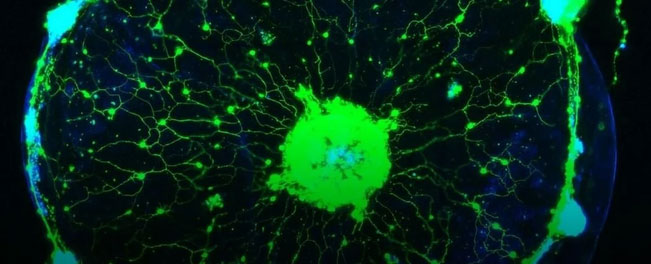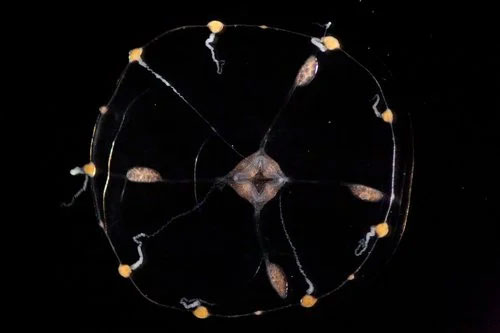Scientists have just discovered a way to read the mind of jellyfish, which have no brains
Although jellyfish don't have brains, scientists have found a way to read their minds.
With a slight genetic change, we can now monitor how the neurons inside the transparent jellyfish operate to produce complex autonomous movements (catch and eat prey).
The jellyfish called Clytia hemisphaerica (C.hemisphaerica) is the perfect organism to study because of its very small body size (about a centimeter in diameter), so the entire nervous system can fit under a microscope. Because.

Jellyfish Chemisphaerica has a fairly simple genome.
Chemisphaerica has a fairly simple genome, its transparent body contains only about 10,000 nerve cells. This is better for observation. The researchers genetically engineered the jellyfish so that their neurons glow when activated, they found 'unexpected levels of structured neural organization'.
The nervous system of jellyfish evolved more than 500 million years ago and has changed little since. Compared to the brains of today's animals, the neurons of living fossils are much simpler to arrange.
Jellyfish don't have a central brain, how can they move or hunt?
Research shows that Chemisphaerica's neurons are organized in the shape of an umbrella, closely mirroring their bodies. These neurons are then divided into slices, like slices of cake.
Each tentacle below the jellyfish's bell will connect to one of these slices. When the tentacles detect and capture prey, the neurons immediately activate in a specific sequence.

The neurons of Chemisphaerica are organized in the shape of an umbrella.
First, neurons in the parietal slice send messages to neurons in the middle, which control the jellyfish's mouth. This causes the slice to move the tentacle toward the jellyfish's mouth. Meanwhile, the mouth part also points towards the incoming food.
After familiarizing themselves with their prey, the brine shrimp (Artemia), the researchers found that of the 96 percent of jellyfish that tried to "switch the food," 88 percent succeeded. Most brine shrimp are caught and eaten by creatures with such a predatory way.

This image depicts the edge slice of a bent jellyfish carrying the shrimp towards its mouth.
To find out what type of nerve cell was triggering this domino effect, the researchers deleted a type of neuron called RFa+ on the limbal slice. The results showed that asymmetric folding inside the jellyfish neurons did not occur, so the transfer of food from the tentacles to the mouth also failed.
"RFa+ neurons are required for both food- and chemical-induced crimping. In contrast, swimming and crumpled movements were not disturbed, suggesting a cell type. Other neurons control that behavior,' the researchers said.
To see how the neurons that control the jellyfish's mouth work with the cells that control the bells and vice versa, the team surgically removed some of their body parts.
With their mouths removed, jellyfish continue to move food from their tentacles toward their nonexistent mouth. After removing many of the tentacles, they found that the chemicals secreted by the shrimp could still trigger the mouth to turn towards the food.
The study showed that certain jellyfish behaviors are governed by various groups of neurons with different functions, scattered around the perimeter of the umbrella. For example, the network of neurons that connect the jellyfish's bell and mouth can also connect to the digestive system.
When the jellyfish in the study were starved of food, the team found that their tentacles moved faster to capture prey than when they weren't hungry. Thereby verifying one thing, when hungry, some neural feedback informs the jellyfish that it needs to fill up its digestive system, putting the organs responsible for feeding on high alert.
"If this hierarchical view is correct, coordinated behaviors in cephalopods such as jellyfish would emerge through autonomic (small-unit) transcription and modification to form metaphyseal tissues." modules are functionally interoperable. How such interactions are formed is the question that scientists are trying to solve,' the researchers hypothesized.
- America makes mind reading machines
- Reading novels will help the brain develop
- 65 interesting things about jellyfish (1)
- US scientists find out how to read human thoughts
- The first purple jellyfish on the planet
- Startled with the danger of jellyfish invading the oceans
- Jellyfish species can 'knock down' American carriers
- 65 interesting things about jellyfish (2)
- Beautiful sparkling jellyfish kingdom
- Do you know how jellyfish burn us?
- Discover the first individual Caribbean jellyfish in Australia
- Animals do not heart, do not brain swim wonders
 Surprised: Fish that live in the dark ocean still see colors
Surprised: Fish that live in the dark ocean still see colors Japan suddenly caught the creature that caused the earthquake in the legend
Japan suddenly caught the creature that caused the earthquake in the legend A series of gray whale carcasses washed ashore on California's coast
A series of gray whale carcasses washed ashore on California's coast Compare the size of shark species in the world
Compare the size of shark species in the world